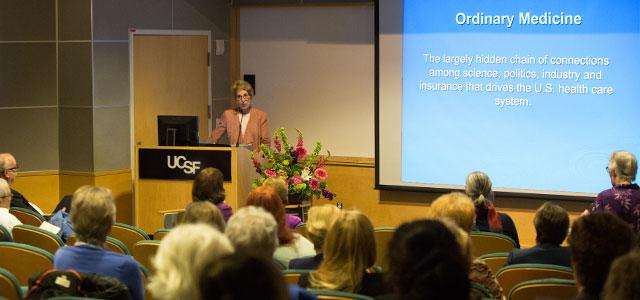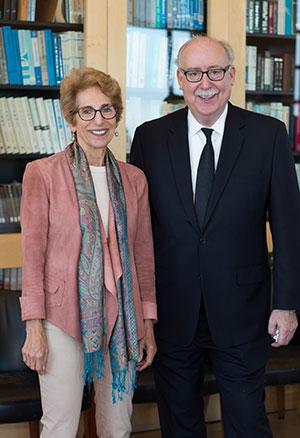
Sharon Kaufman delivers the 36th Helen Nahm Research Lecture at the UCSF School of Nursing (photos by Elisabeth Fall).
Sharon Kaufman Talks About Ordinary Medicine, Extraordinary Treatments, Longer Lives and Where to Draw the Line
“Today in the US, most deaths, regardless of the person’s age, are considered premature,” medical anthropologist Sharon Kaufman said during the 36th Helen Nahm Research Lecture, which she delivered on May 26 at the UC San Francisco School of Nursing. To the audience of health science students, clinicians and researchers, she posed the increasingly urgent question “Where is the line between ‘enough’ and ‘too much’ treatment?”
Investigating How We Want to Age and Die
It’s a complex topic that has intrigued Kaufman – who is professor emerita in UCSF’s Institute for Health & Aging and the School’s Department of Social and Behavioral Sciences, and current chair of the School of Medicine’s Department of Anthropology, History and Social Medicine – since the beginning of her career, as a student in the UCSF Medical Anthropology doctoral program, where she started a research program that has explored the intersection of aging, culture, health care delivery and biotechnology with ethics, governance and medical practice.
As Kaufman told the audience, there’s a profound disconnect between how most people want to die – at home, without tubes and machines – and how we actually die – largely in hospitals, after a prolonged stay in the intensive care unit. Kaufman said, “I wanted to continue investigating why and how, so I began to pay closer attention to how hospital routines and complaints are anchored in other, more far-reaching social phenomena.”
She recounted her observations of older patients, their physicians and families trying to determine what and how much life-prolonging therapy to undergo. The themes of those discussions led her to examine how the biomedical economy and industry affect decisionmaking when life is at stake.
Ordinary Medicine
 Sharon Kaufman with Dean David Vlahov “Ordinary medicine” is Kaufman’s term for the “largely hidden chain of connections among science, politics, industry and insurance,” which has driven the US health care system to consider any technology or practice that prevents death a standard of care. Kaufman says drivers that affect how geriatric and end-of-life medicine is practiced and how patients and families experience it include the following: more industry, with increasing private funding of biomedical research and greater public attention to clinical trials; more treatment options, which make it difficult for patients and clinicians to turn down therapies; and the aging of the US population.
Sharon Kaufman with Dean David Vlahov “Ordinary medicine” is Kaufman’s term for the “largely hidden chain of connections among science, politics, industry and insurance,” which has driven the US health care system to consider any technology or practice that prevents death a standard of care. Kaufman says drivers that affect how geriatric and end-of-life medicine is practiced and how patients and families experience it include the following: more industry, with increasing private funding of biomedical research and greater public attention to clinical trials; more treatment options, which make it difficult for patients and clinicians to turn down therapies; and the aging of the US population.
The evolution of implantable cardiac defibrillators (ICDs) is one illustration of how these phenomena shape thinking and, in turn, the experiences of aging and dying, said Kaufman. As she noted, these devices are designed to prevent the kind of death many patients at the end of life say they want: a sudden one, without aggressive – and ultimately futile – medical treatment. Yet, as these devices have become smaller and safer, they have increasingly been investigated for and marketed to an expanding group of patients, and have become a standard of care for patients with moderate to severe heart disease.
The Effect of New Technology on Patients and Clinicians
While preventing sudden death is unquestionably beneficial for younger, otherwise healthy heart disease patients, who may expect to gain years of good quality of life, most ICDs are placed in older, sicker patients than those the device was originally tested for, and many are placed in people over age 90. This phenomenon, said Kaufman, has moved the goalposts from preventing premature death to prolonging a chronic disease process, without improving health and instead requiring additional intervention to maintain a declining level of health.
She illustrated this with the story of Sam Tolleson, an 88-year-old man with long-term cardiac disease who had received an ICD at age 80, after a second heart attack. After six years with the device, he began receiving multiple shocks on a regular basis (at one point, receiving five in a single day). “They were more and more painful. The very thought that I was going to have another one, I couldn’t take it,” he told Kaufman. Tolleson decided to have his ICD turned off. His physicians and family were dismayed at his decision, but he prevailed, telling them of the decrease in his quality of life. Tolleson died two days after Kaufman spoke with him about his experiences.
Kaufman urged the audience to think about the context in which Tolleson had to make – and defend – his decision: “This is where the evidence has come to rest…in the kind of death we are asked to choose, and in a new, uncomfortable engagement with one’s own role in the timing of death.”
Patients are not the only ones grappling with these questions, Kaufman said. Technologies like the ICD, and the drivers behind their extensive use, force clinicians to confront new ethical dilemmas on a regular basis. The notion of placing an ICD in a patient over age 80 may once have seemed extreme but has now become commonplace, a fact that is disquieting on a personal level for some physicians Kaufman has interviewed. One physician she quoted said, “I feel my threshold [for implanting ICDs] changing, and I feel me changing as well.”
The Intersection of Personal and Social Issues in Aging
New and improving technologies for extending life intensify debates about social, economic and cultural issues surrounding aging and dying as well. In a world where it is increasingly common for younger people to donate organs to parents, or even grandparents, there are new expectations about familial obligation, love and the meaning of care, Kaufman said. These very personal questions intersect with societal questions about the best use of scarce resources (both the organs themselves and the costs of transplant). “How can we think about the conundrum of individual versus social benefit? Of age and allocation?” Kaufman asked.
The good news, said Kaufman, is that, despite the influence of drivers of “ordinary medicine,” medical science continues to consider and attempt to address questions of both extending life and improving it. Increasing the availability of effective palliative care and giving serious and systematic attention to overtreatment and its role in suffering are just two examples.
“Hospitals, patient advocacy groups and health care systems are working to change the default away from more intervention so that age, comfort, meaning and mortality are acknowledged,” Kaufman said. “The task at hand is to further reinvent ordinary medicine in and for our aging society.”



